- A tour of Varanasi made me realize that Kashi
is a microcosm of the Indian Civilisation.
As I stood on the steps of Assi ghat, the first rays of sunlight bathed my
face. The silence and serenity of the majestic Ganges was overwhelming. The
waters were still and a few old row boats, languidly collided with each other,
vying for the space on the banks. A young
couple boarded a boat, and the boatman effortlessly rowed into the horizon. On
the steps of the Ghat, the locals, devotees and students, were engrossed in
their own thoughts and went about their respective tasks in respectful silence.
A few devotees, scantily clad, dipped themselves in the river, in a symbolic ritual
of purification. Younger boys energetically swam at a faster pace.
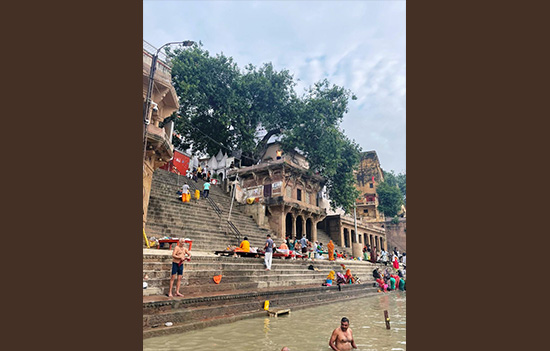 Assi ghat early morning.
Assi ghat early morning.
 Assi ghat, early morning.
Assi ghat, early morning.
I was standing at a spot, built in the 5th Century CE, in one of the oldest inhabited cities in the world, where in spite of all the advent of modernity, things remain the same. This image, captured in my mind – would be a scene not very different from that of a bystander standing on the very same spot 2000 years ago.
On these very steps, one of Indias most famous playwrights – Sant Tulsidas wrote the revered Ramcharita Manas. I walked over to his home, converted to Tulsidas Ashram which is a few steps above the ghat, through a labyrinthine lane. It consisted of a small bare room with minimal furniture, but what stood out were two windows, on two corners of the side facing the Ganges. The windows were open from the top till the floor. Both these windows overlooked the Ganges. As the gentle sunlight caressed the room, through these windows, it dawned on me that the windows made an ideal setting for a person to write, meditate or just to get lost in one’s thoughts. The Sants Khadau (wooden slippers) were
lying there. They appeared rough, uneven and of a rather large size.
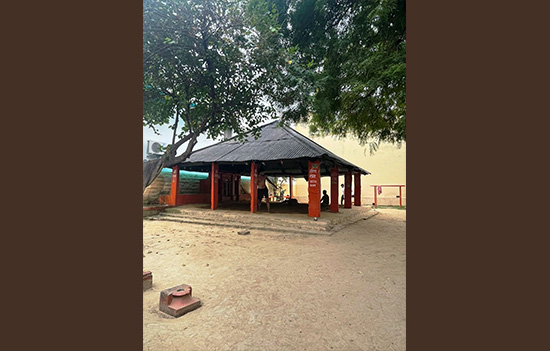 Wrestling Pit, Tulsi Akhara.
Wrestling Pit, Tulsi Akhara.
My next stop was the Tulsi Akhara. It was small, square sand-filled
wrestling pit of approx 20 * 20 sq ft. The area outside the pit was open and
contained equipment for bodybuilding. Wrestling and bodybuilding are age-old
traditions of Varanasi, which boys are initiated into at a very young age.
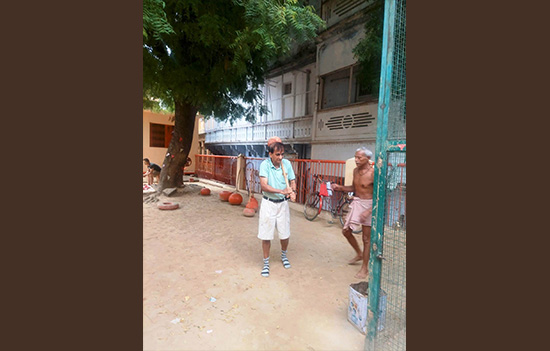 Me trying
to lift a Gada.
Me trying
to lift a Gada.
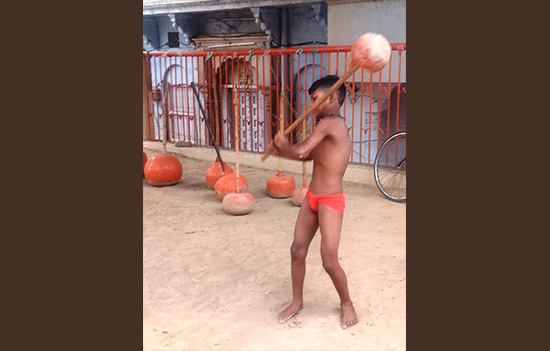 Child in Akshara lifted the Gada so easily.
Child in Akshara lifted the Gada so easily.
Most of the equipment consisted of Gadas loosely translated as a mace. It
consists of a wooden stick with rounded weights. You hold the Gada with both
your hands and swing it around you. I
tried my hand with the lightest weight and struggled. The Pahalwan in charge of
the Akhara, called a scrawny kid who amazingly picked up the weight with great
dexterity. Embarrassed at my own
inability, I mumbled my lack of fitness to a busy schedule.
As we walked narrow lanes, we saw a
couple of Gurukuls. They are a traditional system
of learning in India, wherein the students live with a Guru and are taught
mostly religious scriptures, rituals, and Sanskrit. Students are given free
education and living quarters. They are expected to carry on the tradition.
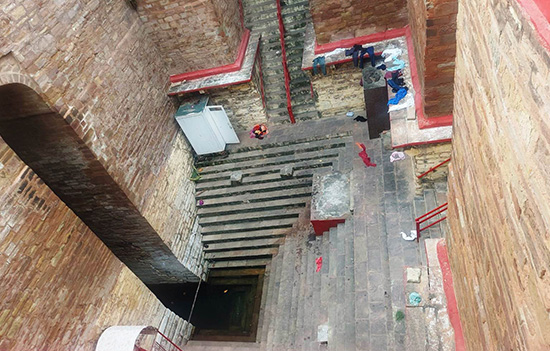 Lolark Kund.
Lolark Kund.
Our next stop was at the Lolark Kund. A kund is a waterbody which accumulates rainwater or collects groundwater. The Lolark Kund located close to Assi Ghat was squarish, open to the sky, with approximately 75 steps below the ground that lead to the water tank. It was closed at that time. This particular Kund is considered extremely auspicious, especially for childless couples, who believe that taking a dip in the kund, will help them become parents. This kund dates back to 1000 CE….
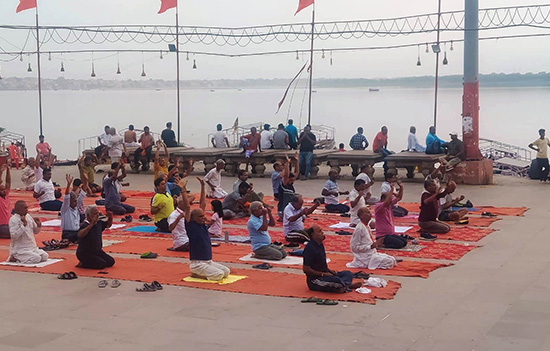 Yoga class at Assi ghat.
Yoga class at Assi ghat.
We walked back to the Assi ghat to the
strains of devotional music, which was followed by a Yoga
Session. On a horizontal stretch of the ghat, a yoga guru was leading a
group of approximately 150-200 people (men and women) who were rigorously doing
Pranayam. The scene was surreal! The rhythmic beat of people breathing in
unison, amidst a calm gentle breeze, on a river bank, created an intensely
positive vibe. This was an open-air yoga class, free for everyone, imparting wisdom
in a natural ambience. It was a contrast to the Bikram Yoga or the Beer Yoga
that passes off as Yoga in the west.
Our last halt and appropriately so, was
the Harishchandra Ghat. Unlike the Assi Ghat
and Tulsi Ghat, here the atmosphere is more solemn. This is the Ghat where
people are cremated. When we reached, there were 5 bodies being cremated
simultaneously. The Doms are families
who have traditionally carried out this task that is passed on from generation
to generation. There are approximately 600 families who are still engaged in
this activity. We stood respectfully at a distance and watched in silence as
smoke emerged from the fires whilst the bodies attained salvation. Cremations
take place at Manikarnika ghat and the Harishchandra ghat. At any hour of the
day or night, if you pass by these ghats, you will witness permanent fires, a
symbolism of the transitory nature of lives.
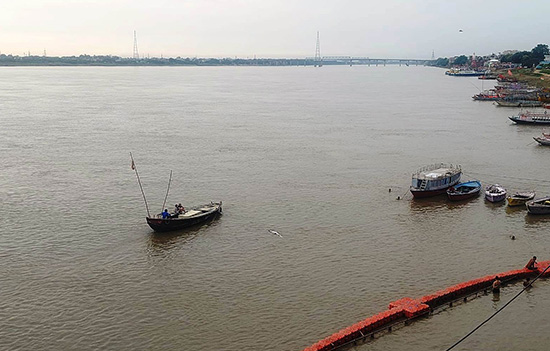 Ma Ganga.
Ma Ganga.
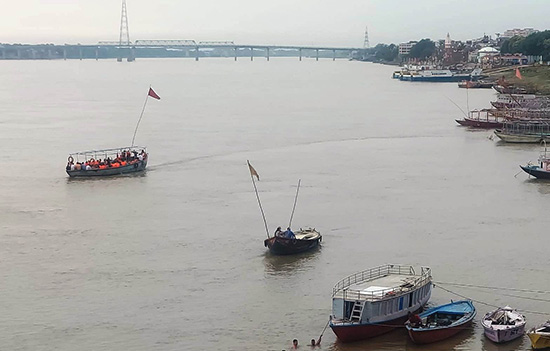 Ma Ganga.
Ma Ganga.
On the surface, one may describe
Varanasi as an ocean of humanity with human tides that drifts towards the Ghats
wave after wave, a cacophony of noises and horns, labyrinthine lanes with the
stench of sewage.
But when you scratch the surface and dig
deeper, you realise that Varanasi defies description.
Kashi is a microcosm of
our glorious Indian culture and civilisation.
To read all
travelogues by author
Also
read
1. Why
do devotees visit Kashi
2. Varanasi – A passage to Immortality
3. Kashi,
Ayodhya, Prayag Yatra
4. Album
Dev Deepavali Kashi
5. Album
Ghats of Kashi
6. Album Temples
of Kashi
7. Album
how locals celebrate Dev Deepavali
8. Kashi,
Ayodhya, Prayag Yatra
9. Album
Ramnagar Fort